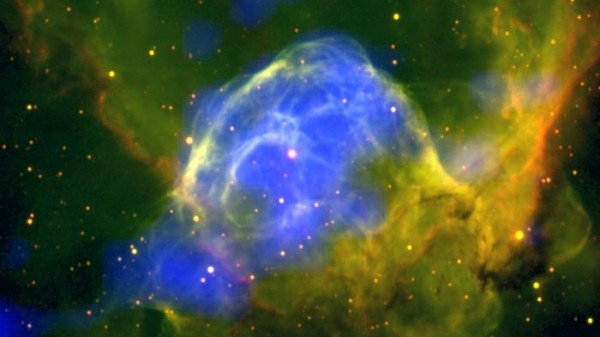Behold Thor's Helmet, a Stunning Hot Mess of a Nebula
| Ana Verayo | | Apr 22, 2015 09:34 AM EDT |
(Photo : J.A. Toala & M.A. Guerrero (IAA-CSIC), Y.-H. Chu (UIUC/ASIAA), R.A. Gruendl (UIUC), S. Mazlin, J. Harvey, D. Verschatse & R. Gilbert (SSRO-South) and ESA) This brightly coloured scene shows a giant cloud of glowing gas and dust known as NGC 2359 or Thor's Helmet nebula.
The European Space Agency just released a stunning image of the bright nebula called NGC 2359, also known as Thor's helmet, since its gas arches and bluish center bulge resembles the Norse god's winged helmet.
This amazing image is actually a composite of two photos captured by the ESA's XMM-Newton space observatory's EPIC cameras along with the Stars and Shadows Remote Observatory South located at the Cerro Tololo Inter-American Observatory.
Like Us on Facebook
These ultra vivid colors provide clues as to the nebula's composition. The brilliant blue patches reveals X-ray emissions detected by the EPIC cameras while the red and eerie green regions are aglow with ionized hydrogen and oxygen as seen by the Stars and Shadows cameras.
These intense X-ray emissions originate from a Wolf-Rayet star located at the center of the HD 56925 nebula. This particular star is s ancient and massive and it releases great amounts of material at a spinning rate equivalent to the energy released by the Sun over 100,000 years.
Apart from this colossal mass loss, winds traveling inside the nebula are detected at 932 miles per second.
This chaotic, violent interaction within Thor's helmet has produced a somewhat messy structure. The central bulge is enshrouded in gaseous filaments and thick dark dust along with bright energy bursts are all interstellar material being swept away by winds, producing powerful shock waves that ripple across the nebular region.
The hottest regions in Thor's helmet have the coolest colors, specifically the blue blowout near the lower left and central region.
Astronomers believe gas swirling inside NGC 2359 can reach scorching temperatures between seven million to 10 million degrees. Thor's helmet is about 15,000 light years away from Earth and spans 30 light years across.
TagsBehold Thor's Helmet, a Stunning Hot Mess of a Nebula, thor's helmet, nebulas, ESA, thor's helmet nebula ESA
©2015 Chinatopix All rights reserved. Do not reproduce without permission
EDITOR'S PICKS
-

Did the Trump administration just announce plans for a trade war with ‘hostile’ China and Russia?
-

US Senate passes Taiwan travel bill slammed by China
-

As Yan Sihong’s family grieves, here are other Chinese students who went missing abroad. Some have never been found
-

Beijing blasts Western critics who ‘smear China’ with the term sharp power
-

China Envoy Seeks to Defuse Tensions With U.S. as a Trade War Brews
-

Singapore's Deputy PM Provides Bitcoin Vote of Confidence Amid China's Blanket Bans
-

China warns investors over risks in overseas virtual currency trading
-

Chinese government most trustworthy: survey
-

Kashima Antlers On Course For Back-To-Back Titles
MOST POPULAR
LATEST NEWS
Zhou Yongkang: China's Former Security Chief Sentenced to Life in Prison

China's former Chief of the Ministry of Public Security, Zhou Yongkang, has been given a life sentence after he was found guilty of abusing his office, bribery and deliberately ... Full Article
TRENDING STORY

China Pork Prices Expected to Stabilize As The Supplies Recover

Elephone P9000 Smartphone is now on Sale on Amazon India

There's a Big Chance Cliffhangers Won't Still Be Resolved When Grey's Anatomy Season 13 Returns

Supreme Court Ruled on Samsung vs Apple Dispute for Patent Infringement

Microsoft Surface Pro 5 Rumors and Release Date: What is the Latest?










